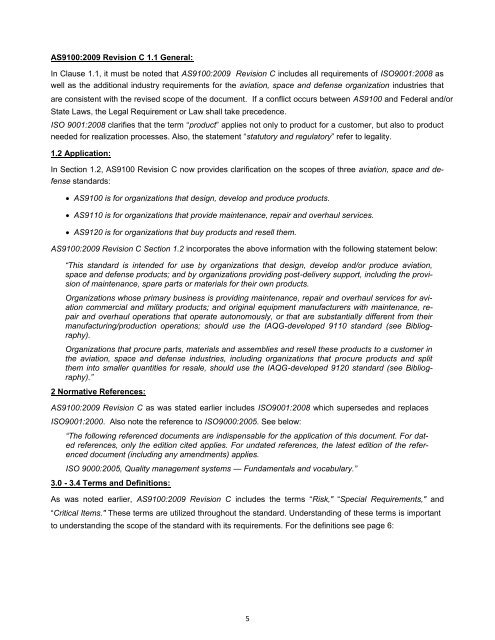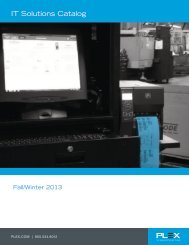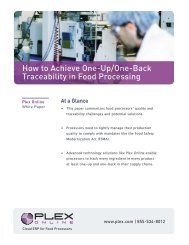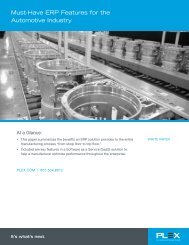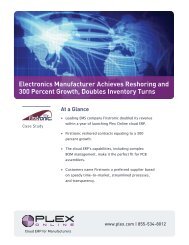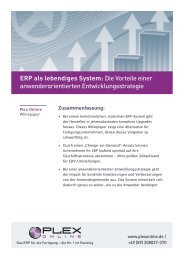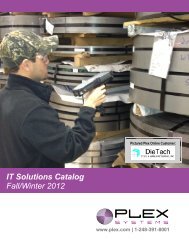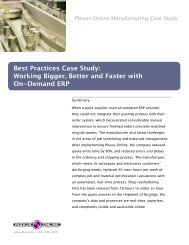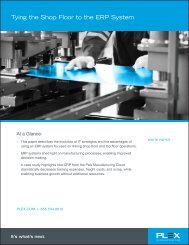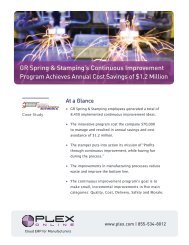How to Comply with Rev. C. - Plex Systems
How to Comply with Rev. C. - Plex Systems
How to Comply with Rev. C. - Plex Systems
You also want an ePaper? Increase the reach of your titles
YUMPU automatically turns print PDFs into web optimized ePapers that Google loves.
AS9100:2009 <strong>Rev</strong>ision C 1.1 General:<br />
In Clause 1.1, it must be noted that AS9100:2009 <strong>Rev</strong>ision C includes all requirements of ISO9001:2008 as<br />
well as the additional industry requirements for the aviation, space and defense organization industries that<br />
are consistent <strong>with</strong> the revised scope of the document. If a conflict occurs between AS9100 and Federal and/or<br />
State Laws, the Legal Requirement or Law shall take precedence.<br />
ISO 9001:2008 clarifies that the term “product” applies not only <strong>to</strong> product for a cus<strong>to</strong>mer, but also <strong>to</strong> product<br />
needed for realization processes. Also, the statement “statu<strong>to</strong>ry and regula<strong>to</strong>ry” refer <strong>to</strong> legality.<br />
1.2 Application:<br />
In Section 1.2, AS9100 <strong>Rev</strong>ision C now provides clarification on the scopes of three aviation, space and defense<br />
standards:<br />
AS9100 is for organizations that design, develop and produce products.<br />
AS9110 is for organizations that provide maintenance, repair and overhaul services.<br />
AS9120 is for organizations that buy products and resell them.<br />
AS9100:2009 <strong>Rev</strong>ision C Section 1.2 incorporates the above information <strong>with</strong> the following statement below:<br />
“This standard is intended for use by organizations that design, develop and/or produce aviation,<br />
space and defense products; and by organizations providing post-delivery support, including the provision<br />
of maintenance, spare parts or materials for their own products.<br />
Organizations whose primary business is providing maintenance, repair and overhaul services for aviation<br />
commercial and military products; and original equipment manufacturers <strong>with</strong> maintenance, repair<br />
and overhaul operations that operate au<strong>to</strong>nomously, or that are substantially different from their<br />
manufacturing/production operations; should use the IAQG-developed 9110 standard (see Bibliography).<br />
Organizations that procure parts, materials and assemblies and resell these products <strong>to</strong> a cus<strong>to</strong>mer in<br />
the aviation, space and defense industries, including organizations that procure products and split<br />
them in<strong>to</strong> smaller quantities for resale, should use the IAQG-developed 9120 standard (see Bibliography).”<br />
2 Normative References:<br />
AS9100:2009 <strong>Rev</strong>ision C as was stated earlier includes ISO9001:2008 which supersedes and replaces<br />
ISO9001:2000. Also note the reference <strong>to</strong> ISO9000:2005. See below:<br />
“The following referenced documents are indispensable for the application of this document. For dated<br />
references, only the edition cited applies. For undated references, the latest edition of the referenced<br />
document (including any amendments) applies.<br />
ISO 9000:2005, Quality management systems — Fundamentals and vocabulary.”<br />
3.0 - 3.4 Terms and Definitions:<br />
As was noted earlier, AS9100:2009 <strong>Rev</strong>ision C includes the terms “Risk," “Special Requirements," and<br />
“Critical Items." These terms are utilized throughout the standard. Understanding of these terms is important<br />
<strong>to</strong> understanding the scope of the standard <strong>with</strong> its requirements. For the definitions see page 6:<br />
5


